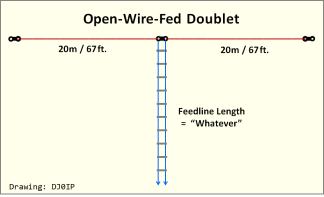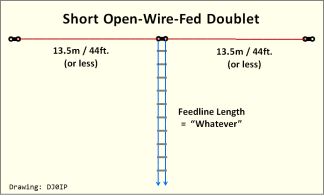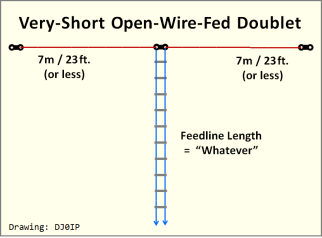Matching Open-Wire-Fed Antennas
Back to the Future
FORWARD
Antennas fed with "Open-Wire Feedline" (a.k.a. 'Balanced-Line', 'Ladder-Line', 'Window-Line', etc.) are once again becoming popular amongst hams who need just one antenna to cover as many bands as possible. Thus the opening comment, Back to the Future.
Some antennas fed with Open-Wire, such as horizontal or vertical loops, are relatively easy to match because their impedance is usually in the range of 100 to 200 Ohms, as long as they are a full wavelength long on the lowest band.
Other antennas, such as center-fed dipoles, are more difficult to match because their impedance varies a lot from band to band and can be all over the map! Matching these antennas can be a real challenge, depending on 'the length of the antenna' (itself), 'the length of the feedline', as well as 'the bands it will be used on'.
Equipment manufacturers (OEM's) often over-hype their products, leading us to the false belief that their 'Super Tuner' can match anything, and do so efficiently. WRONG !!!
Long ago, OEM's offered many different matchbox technologies (e.g., 'Pi-Network', 'Link-Coupling',
'Z-Match', etc.) in addition to the technologies used today (i.e. 'T-Network' and 'L-Network').
IMPORTANT CONSIDERATIONS:
- What is the size (overall length) of the antenna to be matched?
- What bands will the antenna will be used on?
- How muchpower do you want to run with it?
Only after answering these questions can you determine which matchbox technology is your best choice.
First, let's look at some typical antennas:
Back then, open-wire-fed antennas were very common, but back then, at least in America, most hams had large back yards with plenty of space for antennas.
The classical multi-band antenna used back then was a half-wavelength, center fed "Hertz antenna" - which today is known as a "dipole". The only difference is, it was fed with Open-Wire feedline, not coax.
So back then, when we spoke of an all-band antenna covering 80 thru 10m, we were talking about an antenna that is some 130+ ft. (40m) long! Back then, a Johnson Viking Matchbox was considered the best way to match this antenna.
But what about today?
Today, most hams everywhere do not have enough space to errect full-size a half-wavelength 80m dipole. Today hams are deploying much shorter center-fed antennas and often calling them "doublets" or "double-Zepp" antennas.
Although an 80m dipole should be about 132 ft. (20m) long, when shortened to just 111 ft. (34m) and fed with Open-Wire, the antenna seems to perform as good as a full-size antenna. In addition, it is usually easier to match on the harmonic frequencies. And, when shortened to just 88 ft. (27m) long, it is still a fairly efficient antenna. Once reaching the half-size mark (2x 10m or 66ft. total length), efficiency loss is noticible. In addition, many common antenna matchboxes cannot find a match (low SWR) on 80m.
Matching these somewhat shorter antennas can still be accomplished with a Johnson Viking Matchbox, or an Annecke Koppler (its German counterpart) but are the still the best technology for the job?
After that, when we shorten it even farther, three things happen:
- Efficiency begins to drop rapidly.
- The impedance also drops rapidly.
- The antenna becomes more difficult to match on the lower bands.
Very few antenna matchboxes can match this short antenna on 80m and matching on 160m is VERY difficult - almost impossible. Even if we find a solution to match it on 160m, efficiency is so poor that we believe the antenna is very bad on that band. The fact is, when using the right matchbox technology, this is still a very good antenna even on 80m. You won't necessarily bend anyone's S-Meter, but you can still have a decent signal, at least for local (NVIS) work.
On 160m it can also be a fairly good antenna, at least for local work.
The trick is to know "which technology" works here!
I know of no antenna matchbox currently in production that can work efficiently here but that doesn't mean it is impossible. In fact we shall show you how to do this on another page of my web, using solutions proposed by Alfred Kluess, DF2BC.
SUMMARY
As we see above, when speaking of an openwire-fed-dipole (or doublet) we could mean anything from a very long (full-size) antenna to a very short antenna. The matching requirments vary from one to the other, thus we will need a different matching technology for each type if we want the antenna system (antenna + feedline + Matchbox) to radiate efficiently.




























